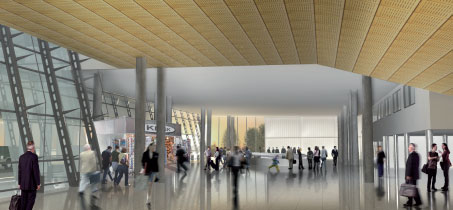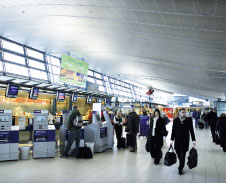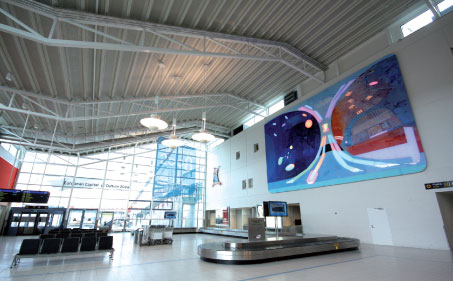
The departure hall expansion in the international terminal at Trondheim Airport is scheduled for completion on 1 May. (Photo: Avinor)
Trondheim Airport, Værnes
On the back of 12 consecutive months of passenger growth in 2011, Trondheim Airport is currently expanding both the international and domestic terminals.
In 2011, the airport handled just short of 4 million passengers – up from 3.5 million in 2010 – and international traffic in particular enjoyed a sharp rise of 19.6%. “There has been a significant increase in the number of international routes over the last few years,” said Lasse Bardal, Airport Manager. In total, 36 international destinations are served from Trondheim, in addition to 19 domestic routes.
The airport in its current guise is designed to handle 3.6 million passengers, so to cater for the additional numbers, measures have been undertaken to expand the space available. Last summer, for instance, a temporary terminal was constructed to increase the non-Schengen hall during the peak period.
A number of permanent developments are also taking place across the airport and the departure hall expansion in the international terminal is scheduled for completion on 1 May. Meanwhile, upgrades to the baggage handling system and an extension to the domestic terminal should be ready for summer 2013. This project includes an increased check-in and security area, increased commercial areas and the addition of new shops and restaurants, and three new airbridges. Six new Code C aircraft stands and a brand new commuter terminal for domestic turboprops will also be complete in 2013.
Following the substantial growth experienced at Trondheim Airport in recent years, ambitious targets have been set for the next three years. Bardal explained that one of these aims is to be the best Norwegian airport from an environmental perspective, while another is to achieve throughput of a “minimum of 1 million international passengers”. When this goal was set in 2010, 520,000 international passengers passed through the airport, rising to 720,000 in 2011. Trondheim also aims to offer the best passenger experience among all major Norwegian airports by 2015.

Trondheim Airport is hoping to achieve 1 million annual international passengers before the end of 2015. (Photo: Avinor)
In order to build on the recent success, the management is currently working closely with politicians and commercial managers in the district to ensure that Trondheim Airport fulfils its potential.
Bardal said: “We are convinced that an effective, international airport with a broad range of destinations and schedules adapted to the needs of the district is vital to develop strong business and industry environments, a strong travel industry and a district that is attractive to live in.” On this front, looking further to the future, the airport’s master plan outlines plans for an airport city, including development of the surrounding road and rail infrastructure.
Stavanger Airport, Sola

Lorentzen: “We are continuously developing new services and products in order to secure a positive experience for our passengers, while at the same time securing an efficient and state-of-the-art infrastructure for our partners.” (Photo: Avinor)
Stavanger Airport has also enjoyed significant passenger growth of late, but a key difference to Trondheim Airport is that it has been driven largely by business traffic. Total passenger numbers climbed from just over 3.6 million in 2010 to 4.1 million in 2011, and business passengers accounted for 53% of this number.
Over the next three years, annual throughput is expected to increase by 8.5% before slowing slightly to around 4% per year from 2015. “Due to the considerable growth in passengers over the last few years, Stavanger Airport has identified the need to upgrade the capacity in several areas,” said Airport Manager Leif Lorentzen.
This year, the security control zone will be enlarged by approximately 80%, while the airside retail and food and beverage offering will also be refurbished. A restaurant and bar has recently opened and a brand new duty free shop will open in June. In the domestic departure hall, a new kiosk was introduced in March, while a coffee bar and full-service restaurant and bar with views of the airfield will be unveiled in the summer.
Lorentzen said: “As the business climate within our industry gets tougher, and the airlines’ profits are challenged, we realise that our future revenues will have to come from commercial activities, rather than airport fees.”
Upgrades to the airbridges and the introduction of a new lounge will also take place before the end of 2013.
“We are continuously developing new services and products in order to secure a positive experience for our passengers, while at the same time securing an efficient and state-of-the-art infrastructure for our partners,” Lorentzen added. “Our vision is to make the journey a little simpler for passengers and partners. Attractive services and products will be of vital importance to meet future industry needs and our financing will to a great extent come from commercial revenues.”
Due to its reliance on business travellers, Stavanger Airport will continue to focus on developing its route network with an emphasis on providing links to destinations that will help contribute to the growth and success of businesses in the region. “That said, we also focus on routes with solid potential for incoming tourism,” Lorentzen said.
With all of these developments ongoing, the overriding ambition is to provide a “seamless and pleasant travel experience” for all passengers, but driving the economic development of the wider region is also high on the list of priorities.

Business passengers accounted for 53% of the 4.1 million passengers who travelled to and from Stavanger Airport in 2011. (Photo: Avinor)







